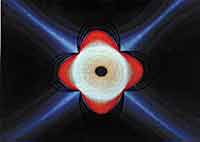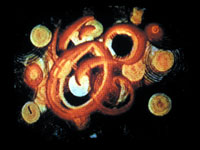|
|
Bach Movies
|
|
F-0116 |
|
|
Title: |
Motion Painting No. 1 |
|
Category: |
S |
|
Produced: |
1947 |
|
Country: |
USA |
|
Released: |
Film: 1947 |
|
Director: |
Oskar Fischinger |
|
Writer: |
|
|
Actors: |
- |
|
Description: |
Motion Painting No. 1 is a 1947 short animated film in which film artist Oskar Fischinger put images in motion to the music of Johann Sebastian Bach's Brandenburg Concerto no. 3, BWV 1048. It is a film of a painting (oil on acrylic glass); Fischinger filmed each brushstroke over the course of 9 months. In 1997, this film was selected for preservation in the United States National Film Registry by the Library of Congress as being "culturally, historically, or aesthetically significant". |
|
A. Prying loose from the Darkness of non-existing infinite possibilities little works of art. - Oskar Fischinger, 1950, describing MP No. 1 in a letter to Margareta Akermark.
B. All my earlier experiments and studies since 1919 lead up to the technique developed in Motion Painting No. 1. The earliest studies of color films found their conclusion in this work which presents in itself an art form of great significance for the future development of motion picture films.
Motion Painting No. 1 draws its importance from the fact that it records the natural, logical growth of a visual form of art which, without any concession, develops its own possibilities. The unknown, unlimited and unborn possibilities of a creative mind, through this technique developed in Motion Painting No. 1, finds its natural, clear way to let the visual expressions flow without any restrictions or chains and reveal the secrets and beauty of art in its purest and most direct way. (Oskar Fischinger, excerpt from unpublished typescript, c1950)
C. ..."Motion Painting Nr. 1" presents in itself a new Artform of great significants, [sic] and enters the Realm of true creativeness in motion in the field of visual expression, changing transmuteing Paintings from a static unmoveable almost frozen formation into painted-created-moving-unfolding developing-music like visual presentation in time - step after step, in such a way, that the time elements adds a most important Quality or Dimension to it. And this is an entirely new kind of music. Music not created by sounds which follow each other in time unfolding the creative Idea feeling or production of a composer, but a music of an essential visual Motion-Painting natur, - resulting from a true creative unfoldment development step by step of a painted visual production of a motion-painter...
The Motion Picture Camera as a Ideal visual recording instrument made in possible in our time, to discover the hidden element of the music-like quality which goes with or is produced by paintings in motion - if they are of a creative nature. The factor of unfoldment of logical growth seems to cary - to produce this music-like almost pleasurable sensation in the observers. (Oskar Fischinger, from unpublished typescript, c 1949) |
|
D. This music, concerto by Bach, is like a smooth river flowing on the side of open fields - And what you see - is not translated music, because music doesn't need to be translated on the screen - to the Eyes music is in itself enough - but the optical part is like we walk on the side of the river - sometimes we go a little bit farther off (away) but we come back and go along on this river, the concerto by Bach.
The optical part is no perfect synchronization of every wave of the river - it is a very free walk, nothing is forced, nothing is synchronized except in great steps.
The film is in some parts perfectly synchronized with the music, but in other parts it runs free - without caring much about the music - it is like a pleasant walk on the side of a river - If the river springs, we on the side do not necessarily spring to it - but go our own free way - sometimes we even go a little bit away from the river and later come back to it and love it so much more - because we were away from it. Sometimes we go up a little while while on the side of the river and the river goes low through a tunnel or under a bridge but we are all the time with the river near the river we hear the sound of the river and we love it and the river is the music of Bach. And what we see are the fields
The optical thought the optical dance to the sound of the river of your soul The flowers of a mind The dance of handwriting and the song of flowers and the white of the clouds and the blue of the sky - Sometimes it is dark and you see in the darkness nothing but your own feeling your own movements your own pulse and the rapture of your heart your blood this is what you see - what goes with the music - The Stars the Heaven the Darkness and the Light of your own love your own heart The Light of your mind, The Dancing Light of your blood - and your feeling (From Fischinger's writings about Motion Painting No. 1, found on 8 narrow strips of paper, n.d. ) |
|
Language: |
English |
|
TT: |
11 min |
|
J.S. Bach's Music: |
Brandenburg Concerto No. 3 in G major, BWV 1048 |
|
Format: |
Film: Color |
|
Company: |
Film: Fischinger Studio |
|
Comments: |
|
|
Buy movie at: |
DVD: CVM's Oskar Fischinger: Ten Films DVD |

 
 
|
|
Watch selections: |
|
|
|
|
Source/Links: IMDB | CVM: Fitschinger | Color and Sound - Visual Music | Wikipedia | Michael Barrier | Finschinger Archiv
Contributor: Aryeh Oron (October 2007); Teddy Kaufman (February 2008) |
|
|